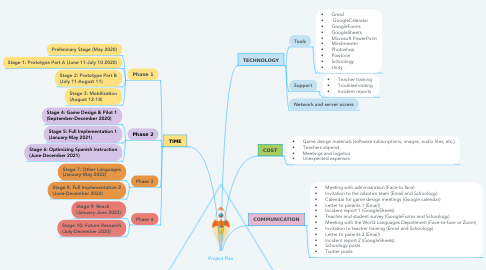
1. COST
1.1. • Game design materials (software subscriptions, images, audio files, etc.) • Teachers stipend • Meetings and logistics • Unexpected expenses
2. TECHNOLOGY
2.1. Tools
2.1.1. • Gmail • GoogleCalendar • GoogleForms • GoogleSheets • Microsoft PowerPoint • Mindmeister • Photoshop • Powtoon • Schoology • Unity
2.2. Support
2.2.1. • Teacher training • Troubleshooting • Incident reports
2.3. Network and server access
3. TIME
3.1. Phase 1
3.1.1. Preliminary Stage (May 2020)
3.1.2. Stage 1: Prototype Part A (June 11-July 10 2020)
3.1.3. Stage 2: Prototype Part B (July 11-August 11)
3.1.4. Stage 3: Mobilization (August 12-18)
3.2. Phase 2
3.2.1. Stage 4: Game Design & Pilot 1 (September-December 2020)
3.2.2. Stage 5: Full Implementation 1 (January-May 2021)
3.2.3. Stage 6: Optimizing Spanish Instruction (June-December 2021)
3.3. Phase 3
3.3.1. Stage 7: Other Languages (January-May 2022)
3.3.2. Stage 8: Full Implementation 2 (June-December 2022)
3.4. Phase 4
3.4.1. Stage 9: Reach (January-June 2023)
3.4.2. Stage 10: Future Research (July-December 2023)
